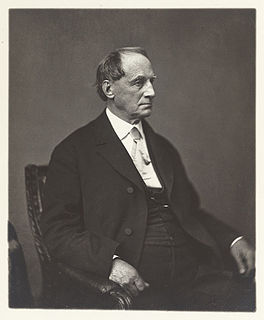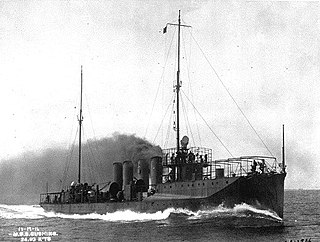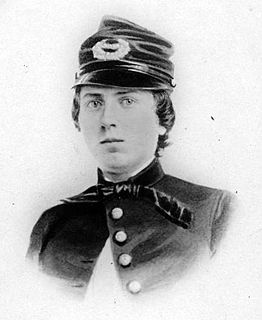
Cushing is a city in Payne County, Oklahoma, United States. The population was 7,826 at the 2010 census, a decline of 6.5% from 8,371 at the 2000 census.

Harvey Williams Cushing was an American neurosurgeon, pathologist, writer and draftsman. A pioneer of brain surgery, he was the first exclusive neurosurgeon and the first person to describe Cushing's disease. He wrote a biography of William Osler in three volumes. Together with Ernest Sachs, he is known as the Father of Neurosurgery.

USS Cushing (DD-985), named after William Barker Cushing, was the fifth ship of the United States Navy to bear the name. Cushing was a Spruance-class destroyer built by the Ingalls Shipbuilding Division of Litton Industries at Pascagoula, Mississippi. Cushing operated out of Yokosuka, Japan for the last several years of her career. Cushing was the last Spruance-class destroyer to remain in active service, until decommissioned on 21 September 2005.

Thomas Cushing III was an American lawyer, merchant, and statesman from Boston, Massachusetts. Active in Boston politics, he represented the city in the provincial assembly from 1761 to its dissolution in 1774, serving as the lower house's speaker for most of those years. Because of his role as speaker, his signature was affixed to many documents protesting British policies, leading officials in London to consider him a dangerous radical. He engaged in extended communications with Benjamin Franklin who at times lobbied on behalf of the legislature's interests in London, seeking ways to reduce the rising tensions of the American Revolution.

Caleb Cushing was an American Democratic politician and diplomat who served as a Congressman from Massachusetts and Attorney General under President Franklin Pierce. He was an eager proponent of territorial and commercial expansion, especially regarding the acquisition of Texas, Oregon and Cuba. He believed that enlarging the American sphere would fulfill "the great destiny reserved for this exemplar American Republic." Cushing secured the first American treaty with China, the Treaty of Wangxia of 1844; it gave American merchants trading rights in five Chinese ports. After the Civil War Cushing negotiated a treaty with Columbia to give the United States a right-of-way for a trans-oceanic Canal. He helped obtain a favorable settlement of the Alabama Claims, and as the ambassador to Spain in 1870s diffused the troublesome Virginius Affair.

CSSEllis was a gunboat in the Confederate States Navy and the United States Navy during the American Civil War. It was lost during a raid while under command of famed Navy officer Lieutenant William B. Cushing.

USS Cushing was an O'Brien-class destroyer built for the United States Navy prior to the American entry into World War I. The ship was the second U.S. Navy vessel named in honor of William B. Cushing, a U.S. Navy officer best known for sinking the Confederate ironclad warship CSS Albemarle during the American Civil War.

Cushing Island, or Cushing's Island, is a privately owned island in Casco Bay in the U.S. state of Maine. Part of the city of Portland, Maine, roughly 45 families live there seasonally.

Cushing Academy is a private, coeducational college-preparatory school for boarding and day students in Ashburnham, Massachusetts, United States. It serves approximately 400 students in grades 9–12 and a postgraduate year.

USS Cushing (DD-376) was a Mahan-class destroyer in the United States Navy before and during World War II. She was the third Navy ship named for Commander William Barker Cushing (1842–1874).

USS Cushing (DD-797) was a Fletcher-class destroyer of the United States Navy, the fourth Navy ship named for Commander William B. Cushing (1842–1874), who distinguished himself during the American Civil War. Cushing was launched on 30 September 1943, by Bethlehem Steel Co., in Staten Island, New York; she was sponsored by Miss Katherine A. Cushing, a daughter of Commander Cushing. The vessel's commissioning was on 17 January 1944, with Commander Louis F. Volk in command.
The Revised Statutes of the United States was the first official codification of the Acts of Congress. It was the precursor to the United States Code.

Alonzo Hereford Cushing was an artillery officer in the Union Army during the American Civil War. He was killed in action during Battle of Gettysburg while defending the Union position on Cemetery Ridge against Pickett's Charge. In 2013, 150 years after Cushing's death, he was nominated for the Medal of Honor. The nomination was approved by the United States Congress, and was sent for review by the Defense Department and the President.

The Ellsworth Court refers to the Supreme Court of the United States from 1796 to 1800, when Oliver Ellsworth served as the third Chief Justice of the United States. Ellsworth took office after the Senate refused to confirm the nomination of Chief Justice John Rutledge, who briefly served as a Chief Justice as a recess appointment. Ellsworth served as Chief Justice until his resignation, at which point John Marshall took office. With some exceptions, the Ellsworth Court was the last Supreme Court to use seriatim opinions.

Thomas Humphrey Cushing was an officer in the Continental Army, and later the United States Army, and finally became a collector of customs for the port of New London, Connecticut.

The Rutledge Court refers to the Supreme Court of the United States from June 1795 to December 1795, when John Rutledge served as the second Chief Justice of the United States. Rutledge took office as a recess appointment of President George Washington to succeed John Jay. However, Rutledge was denied confirmation by the United States Senate, partly due to his attacks on the Jay Treaty. Rutledge was succeeded in office by Oliver Ellsworth. This was the first time that the Senate rejected a Supreme Court nomination; it remains the only time a "recess appointed" justice was not subsequently confirmed by the Senate.
Courtland Cushing was an American lawyer, judge, and diplomat.

















